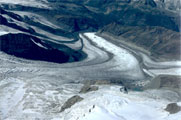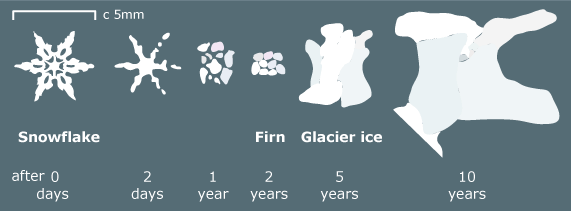 |
|
|
|
|
|
 1 - Gorner- and Grenzgletscher showing a polythermal glacier with a cold accumulation area (76K) |
The formation of a glacier depends mainly on winter precipitation. This precipitation has to be great enough for some of the snow to last throughout the following summer. This sequence must be repeated for several successive years, until finally, under the pressure of its own weight the snow turns to ice. If this ice layer is thick enough, it can flow under the influence of gravity. This transformation of snow to ice is often a long and complex process, both its nature and the time involved depend on ambient temperature and the depth of further, overlying snow. Changes take place fastest in temperate regions, like the Alps and slowest in the polar regions, like the Canadian Arctic, because of the higher temperatures in the former. |
The transformation from snow to ice follows a process chain: Snow crystals have a hexagonal structure with characteristic six-sided symmetry; snow falls in myriad forms. First the fragile crystals break on settling, as they break down if they become wet. Gradually, snowflakes change to grains which become rounded and granular, like coarse sugar. As the snow becomes compressed it becomes harder and denser. At first the air spaces between grains are connected, but now the snow is said to have turned into firn; this is an intermediate stage in its transformation to ice. The firn stage is generally reached after one complete annual cycle, when the snow density approaches half that of water. As these changes proceed, the relatively round grains of firn begin to recrystallise and large ice crystals of ice begin to form at the expense of their smaller neighbours. Air is now only present as bubbles trapped inside the growing crystals. |
|
|
2 - Transformation from snow to ice. Compare this process with the metamorphosis process of snow crystals. |
 |
|
|
|
Glaciers can be roughly classified into different zones. Do you know these zones? |
|
Drag the names on the right side into the corresponding field. If you need additional information about these zones see the table below. |
||
|
A classification was first proposed by Shumskii (1964) and Benson (1961) |
|
||||||||||||||||||||||||||||||||||||||||||||||||||||||||||||
29 August 2011 |
||
| |
||